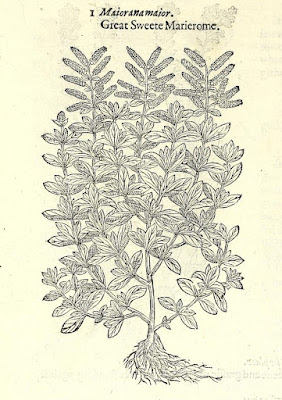16 世紀 John Gerard 的藥草典
《藥草小圈圈》深度認識藥草,這期認識的主角是薰衣草。
查資料、翻藥草學課程講義的過程,發現了1597年有一本英國藥草書, John Gerard 寫的藥草典:The herball, or, Generall historie of plants (1597) by John Gerard,非常好奇。維基百科上有很多資料,討論這本書應該是收錄原以拉丁文寫成的藥草使用紀錄,但裡面有不少錯誤,後來歷經修訂和改版,這一段有些複雜,大家有興趣可以到維基百科John Gerard 的頁面去看。同一時代還有另外一本拉丁文藥草書,作者是 John Parkinson,書名 Paradisi in Sole Paradisus Terrestris(1629)。
也就是說,我猜 Nicholas Culpeper 應該有看過上一段提到的那兩本藥草書。也是因為拉丁文並非一般大眾熟悉的語言,除了造成知識的壟斷之外,當時的醫療服務還抬高藥物的價格,使許多人無法承受。Culpeper 才因此以英文撰寫、羅列當時民間常用療法的藥草與配方。

從藥草學的角度來認識薰衣草,而不是從我非常熟悉的芳香療法、精油的角度來認識薰衣草。不知不覺也寫了20來頁的資料。
***
1597年的藥草書,是什麼樣的年代?台灣有翻譯以兩冊出版的占星藥草學著作:《400年占星藥草醫典》和《400年占星藥草千方》, 作者 Nicholas Culpeper 出生於1616年,他的書 English Physician and Complete Herbal 於1652年出版。
***
回題。
網路搜尋查到 Internet Archive 應該有 John Gerard 的書。但此刻 Internet Archive 正在做資料維修、系統升級,網站暫時離線。(扼腕)
The Herball 連結在此,過兩天再點或許就可以讀到了。
後來搜尋到一篇網路文章,摘錄一些有趣的內容來分享。
***
一首無名作者的打油詩中,記錄了17 世紀的倫敦街頭,有著這樣的販售香草叫賣。藥草,是當時治療疾病的的「藥物」。民眾栽種著家喻戶曉可治療疾病的迷迭香、鼠尾草、百里香,小白菊、甜馬鬱蘭、歐芹、薰衣草等。採收之後來到街頭叫賣出售,給一般家庭作為藥物之用。
Here's fine rosemary, sage and thyme.Come buy my ground ivy.
Here's fetherfew, gilliflowers and rue.
Come buy my knotted marjorum, ho!
Come buy my mint, my fine green mint.
Here's fine lavender for your cloaths.
Here's parsley and winter-savory,
And hearts-ease, which all do choose.
Here's balm and hissop, and cinquefoil,
All fine herbs, it is well known.
Let none despise the merry, merry cries
Of famous London-town!
The Cries of London Anon. (17th century) from Poems on the Underground (Cassell,1997)
文章裡面列出了 John Gerard 的 The Herball (1597) 書中紀錄16 世紀末和 17 世紀初,常用於治療疾病的植物與治療運用方法。收錄花園裡種植的香草,具體的製劑與作用方式。
文章裡面列出了 John Gerard 的 The Herball (1597) 書中紀錄16 世紀末和 17 世紀初,常用於治療疾病的植物與治療運用方法。收錄花園裡種植的香草,具體的製劑與作用方式。
***
關於薰衣草的紀錄。
Of Lavender spike.Gerard records that lavender conserve was used for a variety of complaints affecting the head, including headaches, dizziness and fainting. Pill sized amounts of the conserve were to be taken daily: ‘Conserve made of the flowers with sugar, profiteth much against the diseases aforesaid, if the quantitie of a beane be taken thereof in the morning fasting.’
Gerard 寫說,薰衣草蜜餞被用於影響頭部的各種不適,包括頭痛、頭暈和昏厥。每天服用藥丸大小的蜜餞:「用花和糖製成的蜜餞,如果在早晨齋戒時服用一粒豆子大小,對上述疾病有很大的好處。」
***
關於甜馬鬱蘭的紀錄。(這兩天正在處理庫存的乾燥甜馬鬱蘭^^。)
關於甜馬鬱蘭的紀錄。(這兩天正在處理庫存的乾燥甜馬鬱蘭^^。)
Of Marierome.
"The leaves are excellent good to be put into all odoriferous ointments, waters, powders, broths, and meates." "There is an excellent oile to be drawen foorth of these herbes, good against the shrinking of sinewes, convulsions, and all aches proceeding of a cold cause."
***
小白菊
Of Feverfew.Gerard 觀察到,這種植物要想生長得好,需要良好的排水:「常見的單株小白菊生長在樹籬、花園和古老的牆壁上。它喜歡在瓦礫中生長(娥:可能是貧瘠土壤的意思)。正如它的通用名稱所暗示的,這種藥草用於驅除 「瘟疫 」或發燒。」
As Gerard observes, to grow well this plant requires sharp drainage: "The common single Feverfew groweth in hedges, gardens, and about olde walles. It joyeth to grow among rubbish." As its common name suggest, this herb is used to drive away 'agues' or fevers.

文章裡面還有節錄其他常見與我們不那麼熟悉的藥草,按連結看更多圖片、藥草、與製劑療癒運用。
--
這裡記錄著喜歡香草,喜歡香氛,喜歡喇皂,喜歡料理的女巫阿娥的各種手做皂與香氛小物,分享阿娥的生活種種。喜歡阿娥寫的東西,可以請阿娥喝咖啡,但我會把錢拿去買書。





Comments
Post a Comment